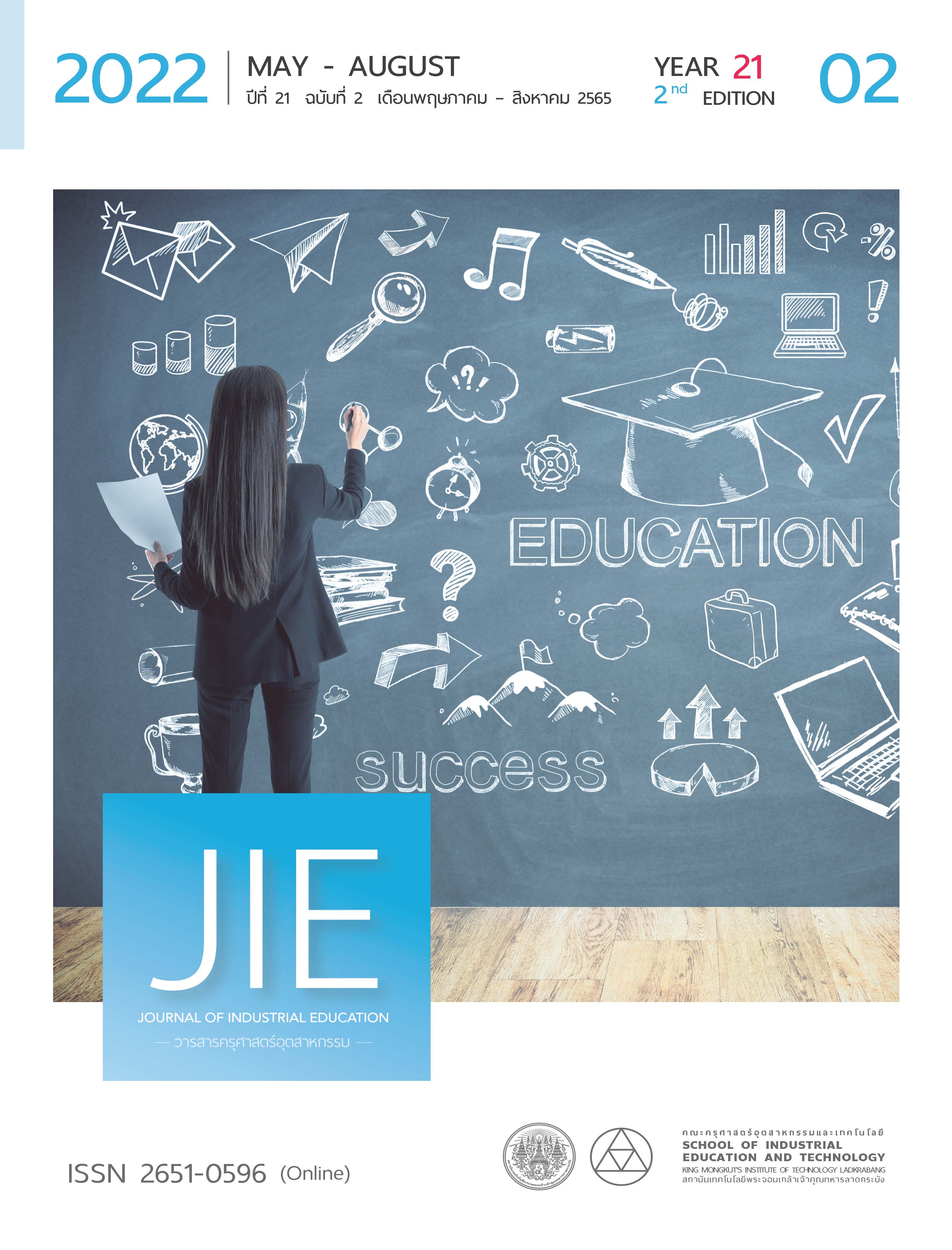IMPACT OF CONSTRUCTIVE ALIGNMENT AND ASSESSMENT IN OUTCOME BASE EDUCATION ON STUDENTS’ LEARNING: CASE STUDY OF AUTOMOTIVE COURSE
Keywords:
Outcome based education, Constructive alignment, Learning outcomes assessment, Automotive practiceAbstract
This research demonstrates the use of outcome-based educational model in the learning management of automotive course. The purposes are designed the outcome-based educational model to create constructive alignment relationships and assess the learning outcomes in the designed curriculum of the Bachelor of Science in Industrial Education Program in Mechanical Engineering (5 Years Program). Five core competencies were evaluated in self directed learning, response and participation, explanation in automotive technology, automotive technology practice, and diagnosis plus problems solving skill. The process design of outcome-based educational, which are objectives and learning outcomes, teaching and learning approaches, and assessment method. The evaluation tools were rubric scoring, job sheets, and ask questions to define the problem to be solved. The statistic used to analyze the results was the percentage of learners who achieved the expected learning outcomes level. The samples, 23 students from the second year of study enrolling in Automotive Electrical and Electronic Technology, were evaluated. The results showed that all students were able to learn, participate, and respond in class by themselves. Furthermore, they were able to reach expected leaning outcomes due to the curriculum and assessment's illustration from the teacher. This could motivate students to have a high attention in the course. In the case of principles and practices in automotive technology, 11 students (47.8%) and seven students (30.45%) could not achieve the expected learning outcomes respectively. There were nine students (39.13%) who could not success in having problem solving skills resulting and the use of assessment tools for the first time. Some students were unable to accomplish the expected learning outcomes. This information provides further improvement for the researcher.
References
Akir, O., Eng, T., & Malie, S. (2012). Teaching and learning enhancement through outcome-based education structure and technology e-learning support. Procedia - Social and Behavioral Sciences, 62, 87–92.
Armstrong, P. (2010). Bloom’s taxonomy. https://cft.vanderbilt.edu/guides-sub-pages/blooms-taxonomy
Biggs, J. & Tang, C. (2011). Teaching for quality learning at university. (4th ed). McGraw-Hill Education.
Brookhart, S. (2013). How to create and use rubrics for formative assessment and grading. ASCD.
Dai, H., Wei, W., Wang, H., Wong, T. (2017). Impact of outcome-based education on software engineering teaching: a case study. In S. Lord (Ed.), 2017 IEEE International Conference on Teaching, Assessment, and Learning for Engineering (TALE) (pp. 261-264). IEEE.
Department of Mechanical Technology Education. (2019). Curriculum of bachelor of science in industrial education, mechanical engineering 5 years program, revised B.E. 2563. https://mte.kmutt.ac.th/bachelor.html. (in Thai)
Faldessai, N., Dharwadkar, A., & Mohanty, S. (2014). Objective-structured practical examination : A tool to gauge perception and performance of students in Biochemistry. Asian Journal of Multidisciplinary Studies. 2(8), 32-38.
Karpin, & Mahmudatussaadah, A. (2020). Student response - based learning: A strategy for improving student participation in learning. Journal of Innovation of Vocational Technology Education, 16(1), 42-52.
Mongkolteeradech, M. (2018). Outcome-based education. https://celt.li.kmutt.ac.th/km/index.php/outcomebased- triangle/comment-page-1/ (in Thai)
Othman, Z., Ya’acob, A., Azman, H., Thang, S. M., Syed Kamarulzaman, S., Hamin Stapa, S., & Wan Mohamad, W. N. A. (2014). Circuit
learning-teacher’s and student’s reactions to an innovative approach in language teaching. Journal of Institutional Research South East Asia. 12(2), 5-21.
Pinit, P., Anmanatarkul, A., & Meearsa, J. (2020). Outcome-based grading in an outcome-based education. Walailak Journal of Learning Innovations, 6(2), 59-96. (in Thai)
Pusic, M. V., Boutis, K., Hatala, R., & Cook, D. A. (2016). Learning curves in health professions education.” Academic nedicine, 90(8), 1034-1042.
Siriwongs, P. (2015, February). Developing student’ learning ability by dint of self – directed learning. 7th World Conference on Educational Sciences (WCES - 2015) (pp. 2074-2079). Novotel Athens Convention Center, Greece., 2074-2079.
Sotthayakom, P., Yoelao, D., & Suwanmonkha, S. (2018). Instructional factors of teachers: Instructional leaders and principals’ perspective. Veridian E-Journal, Silpakorn University, 11(1), 759-772. (in Thai)
Tanprasert, K. (2021). Micro-credentials for professional development for educator. Journal of Learning Innovation and Technology (JLIT), 1(1), 33-43.
Thammawattana, M. (2012). Motivation strategies to efficacy in classroom: Case study of students to practice the teaching in school, Faculty of Education, Burapha University. Journal of Education, 23(3), 17-26. (in Thai)
Tierney, R., & Simon, M. (2004). What’s still wrong with rubrics: Focusing on the consistency of performance criteria across scale levels. Practical Assessment Research & Evaluation, 9(2), 1-10.
Downloads
Published
How to Cite
Issue
Section
License
Copyright (c) 2022 Journal of Industrial Education

This work is licensed under a Creative Commons Attribution-NonCommercial-NoDerivatives 4.0 International License.
"The opinions and contents including the words in papers are responsibility by the authors."
"ข้อคิดเห็น เนื้อหา รวมทั้งการใช้ภาษาในบทความถือเป็นความรับผิดชอบของผู้เขียน"



